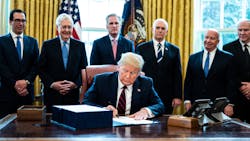COVID-19 Stimulus: How it Helps Fire, EMS Departments
Editor's note: Find Firehouse.com's complete coverage of the COVID-19 pandemic here.
Swiftly on the heels of Congress signing off on it, President Donald Trump signed an historic $2.2 trillion economic stimulus package Friday to help the United States weather the disruption caused by the global coronavirus pandemic.
That package also included more than $163 billion to help fire departments and EMS services across the country deal with the COVID-19 outbreak, according to the International Association of Fire Chiefs. Much of the funding involves ways to reimburse agencies as they handle the influx of people affected by the illness, but it also includes measures to help with the critical shortage of supplies firefighters, EMS workers and other first responders need while battling the virus.
Here's a look at some of the funding earmarked for fire and EMS services, according to the IAFC:
- $100 billion, Public Health and Social Services Emergency Fund: Allotted to eligible healthcare providers to recoup healthcare expenses or lost revenue directly caused by COVID-19. Recipients would include any public entity, for-profit or nonprofit organizations and providers enrolled in Medicare and Medicaid that perform diagnoses, testing or care for coronavirus patient. The IAFC says it will be contacting Admiral Brett P. Giroir, assistant secretary for the Department of Health and Human Service to make sure fire departments would be eligible to apply for funding.
- $45 billion, Disaster Relief Fund: To be used to recover money spent on medical response, acquiring personal protective equipment, National Guard deployment, logistics coordination, implementing safety measures and other related activities. FEMA has indicated that money in this area can be used to pay for 75 percent of overtime and backfill expenses, as well as disinfecting, medical and PPE supplies and apparatus usage, the IAFC says. Fire chiefs are urged to contact Chief Keith Bryant with the U.S. Fire Administration or consult FEMA's fact sheet for its Simplified Public Assistance Application. Chiefs also can get in touch with the emergency managers in their own states in order to initiate the reimbursement process.
- $16 billion, Strategic National Stockpile: This money would go to replenishing PPE and medication supplies.
- $1 billion, Defense Production Act: Funds in this area would work on improving not only the country's supply chain but also the production of PPE, ventilators and other equipment desperately needed when it comes to this pandemic. Money also would be given to federal, state and local agencies to buy these supplies and equipment.
- $100 million, Assistance to Firefighters Grant Program: This area specifically covers reimbursement for PPE and other supplies, and the IAFC is trying to find out when the application period would run.
- $100 million, Emergency Management Performance Grants: FEMA would use these funds to target reimbursements related to emergency preparedness, and the IAFC will provide information about the application process in the future.
- $7 million, U.S. Forest Service's Wildland Fire Management: This account is set up to provide PPE and baseline testing for wildland firefighters, and the Forest Service's chief will have discretion on how the money can be sent. According to the IAFC, the funding is expected to be used by the USDA for wildland firefighting.
The package also sets up measures to remedy medication shortages and includes life-safety measures, such as allowing commercial building fire sprinkler retrofit installations to qualify for bonus depreciation through 2027, as well as a 15-year depreciation period in perpetuity after 2027.
